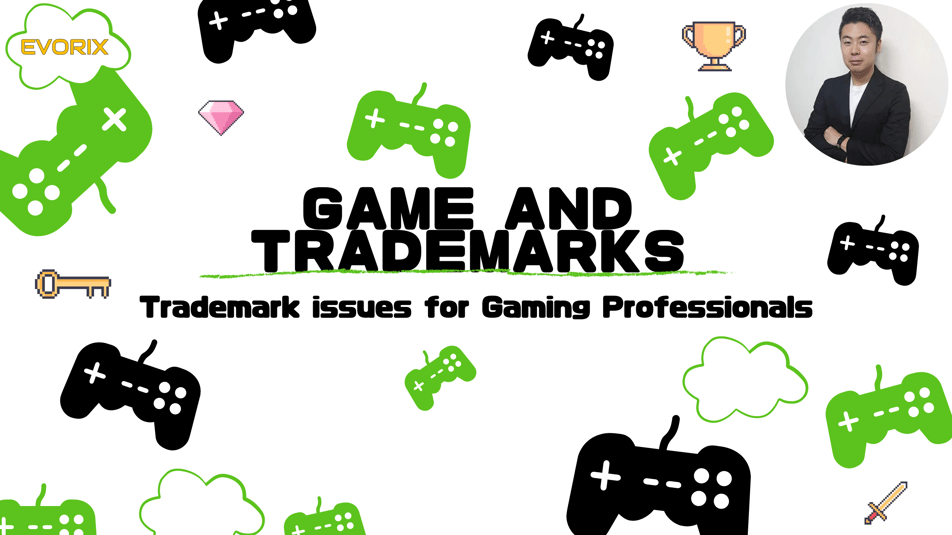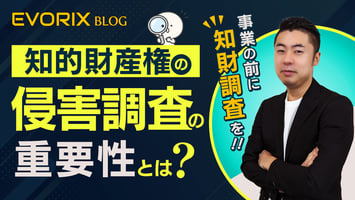Games and Trademarks

The global market scale for game contents in 2021 was approximately 21.9 trillion yen, of which the domestic market scale in Japan was approximately 2 trillion yen.
The gaming market has become a big business, and the demand for trademarks related to games is increasing accordingly. In this point, there is room for consideration as to the scope to which trademarks should be acquired to protect the brand. So, this time, we would like to introduce the relationship between games and trademarks.
[table of contents]
- About a game title
- About a game subtitle
- About an abbreviated name of the game title
- About a game character/an item name/a special move name/lines
- Reference
- Inquiries about this article
About a game title
First of all, we must consider whether the Game title should be protected by a trademark. Generally, a "title" is not registrable as a general rule, as it indicates the quality of the goods or services (see also Examination Guidelines for Trademarks shown in reference 1. below).
https://www.jpo.go.jp/system/laws/rule/guideline/trademark/kijun/document/index/07_3-1-3.pdf
However, the game title is not included in the "title" indicated in the Examination Guidelines for Trademarks. Therefore, in principle, the game title is registered as a trademark as it has a distinctiveness. Game softwares and downloadable game programs are classified in Category 9, and game programs provided online (not downloadable) are classified in Category 41, and thereby be sure to keep at least these two categories in mind.
Here, a question arises as to why titles of books, etc. are not registrable. The reason for this is related to the fact that the title of book merely indicates its content and does not function as a mark indicating its origin and that the book itself is to be protected by a copyright.
In light of those circumstances, it is understood that questions, such as whether the game title merely indicates the game content and does not function as marker and whether the game title cannot be a trademark, may arise.
This question can be understood by studying some cases that have been contended in the past. Here, the "I Am An Air Traffic Controller" case (2001 (Wa) No. 7078) and the "Sangokushi (Romance of the Three Kingdoms)" case (1993 (yo) No. 702) are briefly discussed (see also reference 2. and 3. below).
In the "I Am An Air Traffic Controller" case, it was determined that the game title fulfilled the function as a mark identifying own and other goods.
On the other hand, in the "Sangokushi" case eight years before the above case, it was determined that the "Sangokushi" part could not be recognized as being used in a manner of fulfilling the function of identifying own and other goods, since the "Sangokushi" part was the one whose theme had been taken from the book known as the title of the "Sangokushi engi", and merely indicated the content of the game.
As described above, the opposite decisions have been made in the above two cases. In the latter "Sangokushi" case, there was a fact that the game title was derived from the historical book called "Sangokushi engi", and it is therefore considered that that point was taken into account in the determination that the title of the game refered to the content of the game.
In light of those circumstances, the game title is considered to be registrable as a trademark unless it is of such a nature that it indicates the content of the game. Thus, it is advisable to obtain a trademark registration for the game title unless there are special circumstances.
About a game subtitle
As is well known, some games have subtitles (not dubbeds but different titles) in addition to the main titles. For example, Dragon Quest II has a subtitle of "Pantheon of Evil Spirits", and Dragon Quest XI has a subtitle of "Echoes of an Elusive Age".
If the main title is regarded as a family name, the subtitle can be regarded as a pet name. The subtitle conforms to the game content to a certain extent, but it merely narrates about the game content in the abstract and does not directly and concretely describe the game content.
Therefore, as with the main title, the subtitle also has the function of indicating the origin of the goods, and it is therefore recommended to acquire a trademark for the subtitle as well. Note that "Pantheon of Evil Spirits" and "Echoes of an Elusive Age" are both registered (Trademark Registration No. 5148063 and No. 5826007).
[Trademark Registration No. 5148063]
"Pantheon of Evil Spirits"

[Trademark Registration No. 5826007]
"Echoes of an Elusive Age"

About an abbreviated name of the game title
On the other hand, about the game title abbreviation, there are circumstances in which it is not easy to advise that it should be protected. This is because consumers often begin to use the game title abbreviation as a nickname, and the abbreviation is less characterized by a game developer naming and actively using it. "Maricar" and "Momotetsu" are exemplified as the game title abbreviations.
As a general rule, the registered trademark must be used by the right holder or its licensee in the market. "Use" here means, for example, manufacturing and selling goods bearing the registered trademark. A non-use trademark may have its registration revoked (Nonuse cancellation umpire of Trademarks Act Article 50).
If you create your own game title abbreviation and actively use it, there is a merit in acquiring right to the abbreviation since the risk of non-use is low.
However, even if a game company acquires a trademark for the game abbreviation at a cost, where the abbreviation is created by consumers and used exclusively by them, there is a risk that the trademark registration may be revoked due to non-use of the trademark since the game company do not use the abbreviation.
Thus, it is necessary to consider each specific circumstance to determine whether the trademark registration should be obtained for the game title abbreviation.
About a game character/an item name/a special move name/lines
Regarding trademarks of characters, etc. in a game, these are deeply related to whether or not to develop a business using them, that is, whether or not to commercialize them.
First of all, the characters themselves are not copyrighted, as explained in the previous articles "Character Protection "Copyright and Trademark rights (https://www.evorix.jp/blog/キャラクターの保護著作権と商標権)" and "Notes on Character Business (https://www.evorix.jp/blog/キャラクタービジネスの注意点)".
The character names also have little room for copyright protection. Similarly, the item names and the special move names are highly unlikely to be copyrighted. About the lines, they are also unlikely to be copyrighted, but there is some room for consideration.
Character designs and item illustrations are to be copyrighted, but if you are considering developing goods in the future, we recommend to register the trademarks for them in the goods field in addition to the game field.
If you obtain a trademark registration in advance, for example, when you ask another company to manufacture goods, that is, when you make a license contract, it will be easier to assert that you are the legitimate right holder, and you can therefore smoothly develop your business without causing trouble.
As described above, even though it's a game, there are various protection methods and various strategies regarding the trademarks. We recommend obtaining trademarks not only for the game itself, but also for goods related to the game if there are subsequent business developments.
For your reference, Category 14 "key chains, ornaments, etc.", Category 16 "stationery", Category 24 "towels", Category 25 "clothing", Category 28 "toys (including stuffed animals)", etc. can be exemplified as the goods that are likely to be related to games.
Reference:
※1. Examination Guidelines for Trademarks, Article 3, Paragraph 1, Item 3
Where a trademark is recognized by consumers as a title of a name of broadcast program (hereinafter referred to as “the title, etc.”) in respect of such goods or services as “books,” “production of broadcast programs,” etc. and the title, etc. is found to recognize specific contents, it is judged to indicate the quality of goods or services, since it recognizes the contents of such goods.
※2. I Am An Air Traffic Controller case (2001 (Wa) No. 7078)
https://www.courts.go.jp/app/files/hanrei_jp/831/011831_hanrei.pdf
Considering the following matters, etc. together, it should be said that the defendant's mark "I Am An Air Traffic Controller" part functions as a mark for distinguishing one's own goods from others.
(1) The letters "I Am An Air Traffic Controller" are printed in large letters and in conspicuous colors on the front, sides and back of the outer box of the defendant's software.
(2) The defendant's software and its outer box do not have any marks to distinguish the defendant's software from other companies' goods other than the letters "I Am An Air Traffic Controller".
(3) Although "Air Traffic Control Simulation Game" is written above the letters "I Am An Air Traffic Controller", it is understood that that description briefly explains the contents of the defendant's software.
※3. Sangokushi case (1993 (yo) No. 702)
https://www.courts.go.jp/app/files/hanrei_jp/881/013881_hanrei.pdf
If the meaning of the word "Sangokushi", the content of the Debtor's game, the manner in which the Debtor's mark is used by the Debtor, the ability of the traders and consumers to understand, and other various circumstances are taken as a whole, and if this is compared with the manner of the customary use of titles in books and videos containing movies, etc. the Debtor's Marks are all displayed on the packages as titles that indicate the contents of the computer game program, which is the copyrighted work incorporated in the goods as a creative work.
Furthermore, since the "Sangokushi" part is intended to describe that the game, which is the contents of the images that are the outputs of the program, takes its theme from a book with the title of the "Sangokushi engi" as a creative work, and it can be said that it is displayed in order to quote and display the content of the book, from any point of view, it is not recognized that the mark is used in a manner of fulfilling the function of identifying own and other products.
Inquiries about this article
If you have any questions regarding intellectual property issues such as trademarks, patents, and designs related to games, please feel free to contact us using the form below.
.png?width=500&height=250&name=%E7%9F%A5%E7%9A%84%E8%B2%A1%E7%94%A3%E4%BA%8B%E5%8B%99%E6%89%80%E3%82%A8%E3%83%9C%E3%83%AA%E3%82%AF%E3%82%B9%20(500%20%C3%97%20250%20px).png)

